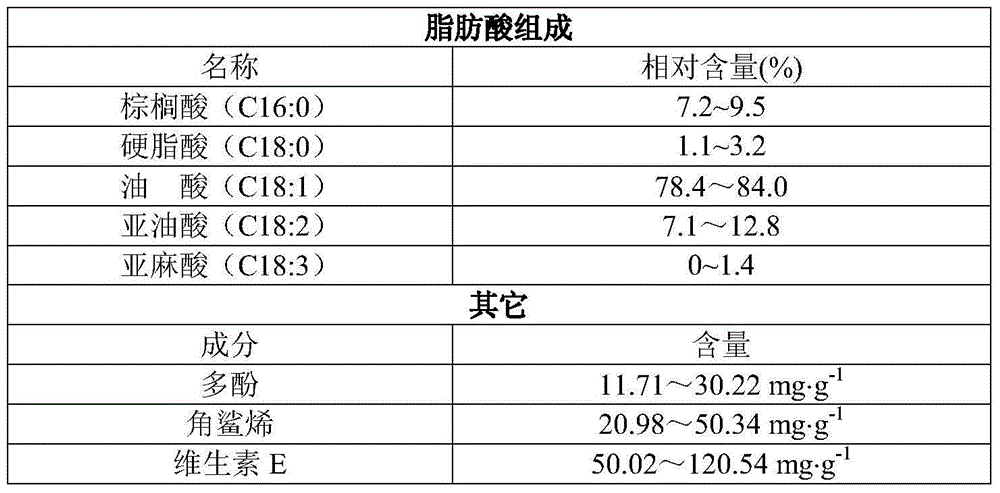Process for preparing cold-pressed camellia oleosa seed oil by virtue of vacuum microwave enzyme method pretreatment
A vacuum microwave and pretreatment technology, applied in the direction of fat oil/fat production, fat production, etc., can solve the problems of loss of nutrients and flavor components, low oil yield, contact pollution of activated clay, etc., to promote dissolution and improve yield The effect of oil rate
- Summary
- Abstract
- Description
- Claims
- Application Information
AI Technical Summary
Problems solved by technology
Method used
Image
Examples
Embodiment 1
[0037] (1) Fruit picking: pick mature camellia oleifera fruit, first stack the camellia oleifera fruit for 5 to 7 days to ripen to increase the oil content, then expose to the sun for 3 to 5 days, and set aside;
[0038] (2) Shelling: adopt sheller to slough off the pericarp and shell of camellia oleifera fruit, for subsequent use;
[0039] (3) Pulverization: pulverize the shelled Camellia oleifera seeds to 10-20 mesh, set aside;
[0040] (4) Enzyme addition: add protease liquid to the pulverized Camellia oleifera seeds at a material-to-liquid ratio of 1:8 (kg / L), the protease activity of the protease enzyme liquid is 800U / mL, and then fully mix evenly;
[0041] (5) Segmented vacuum microwave treatment: transfer the Camellia oleifera seeds obtained through step (4) to a vacuum microwave oven for segmental vacuum microwave treatment; segmental vacuum microwave treatment includes the first section of vacuum microwave treatment and the second section of vacuum microwave treatment...
Embodiment 2
[0046] (1) Fruit picking: pick mature camellia oleifera fruit, first stack the camellia oleifera fruit for 5 to 7 days to ripen to increase the oil content, then expose to the sun for 3 to 5 days, and set aside;
[0047] (2) Shelling: adopt sheller to slough off the pericarp and shell of camellia oleifera fruit, for subsequent use;
[0048] (3) Pulverization: pulverize the shelled Camellia oleifera seeds to 10-20 mesh, set aside;
[0049] (4) Enzyme addition: Add cellulase enzyme liquid to the pulverized Camellia oleifera seeds at a material-to-liquid ratio of 1:12 (kg / L). The cellulase enzyme activity of the cellulase enzyme liquid is 2000U / mL, and then fully well mixed;
[0050] (5) Segmented vacuum microwave treatment: transfer the Camellia oleifera seeds obtained through step (4) to a vacuum microwave oven for segmental vacuum microwave treatment; segmental vacuum microwave treatment includes the first section of vacuum microwave treatment and the second section of vacuum...
Embodiment 3
[0055] (1) Fruit picking: pick mature camellia oleifera fruit, first stack the camellia oleifera fruit for 5 to 7 days to ripen to increase the oil content, then expose to the sun for 3 to 5 days, and set aside;
[0056] (2) Shelling: adopt sheller to slough off the pericarp and shell of camellia oleifera fruit, for subsequent use;
[0057] (3) Pulverization: pulverize the shelled Camellia oleifera seeds to 10-20 mesh, set aside;
[0058] (4) Enzyme addition: add cellulase enzyme liquid to the pulverized Camellia oleifera seeds at a material-to-liquid ratio of 1:8 (kg / L), the cellulase enzyme activity of the cellulase enzyme liquid is 1000U / mL, and then fully well mixed;
[0059] (5) Segmented vacuum microwave treatment: transfer the Camellia oleifera seeds obtained through step (4) to a vacuum microwave oven for segmental vacuum microwave treatment; segmental vacuum microwave treatment includes the first section of vacuum microwave treatment and the second section of vacuum mi...
PUM
 Login to View More
Login to View More Abstract
Description
Claims
Application Information
 Login to View More
Login to View More - R&D
- Intellectual Property
- Life Sciences
- Materials
- Tech Scout
- Unparalleled Data Quality
- Higher Quality Content
- 60% Fewer Hallucinations
Browse by: Latest US Patents, China's latest patents, Technical Efficacy Thesaurus, Application Domain, Technology Topic, Popular Technical Reports.
© 2025 PatSnap. All rights reserved.Legal|Privacy policy|Modern Slavery Act Transparency Statement|Sitemap|About US| Contact US: help@patsnap.com

